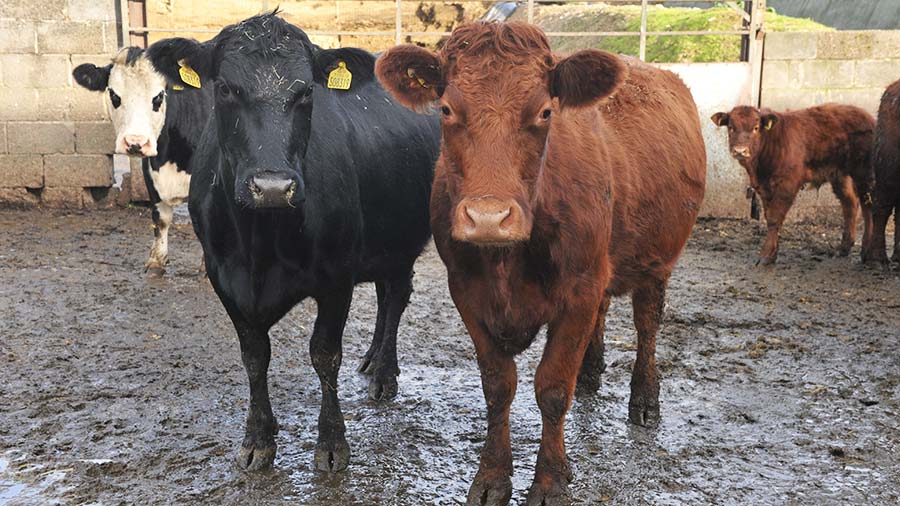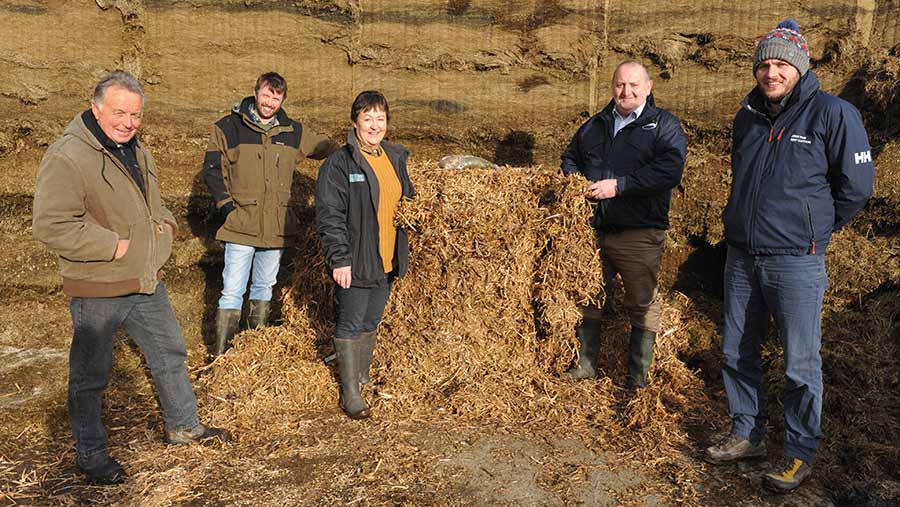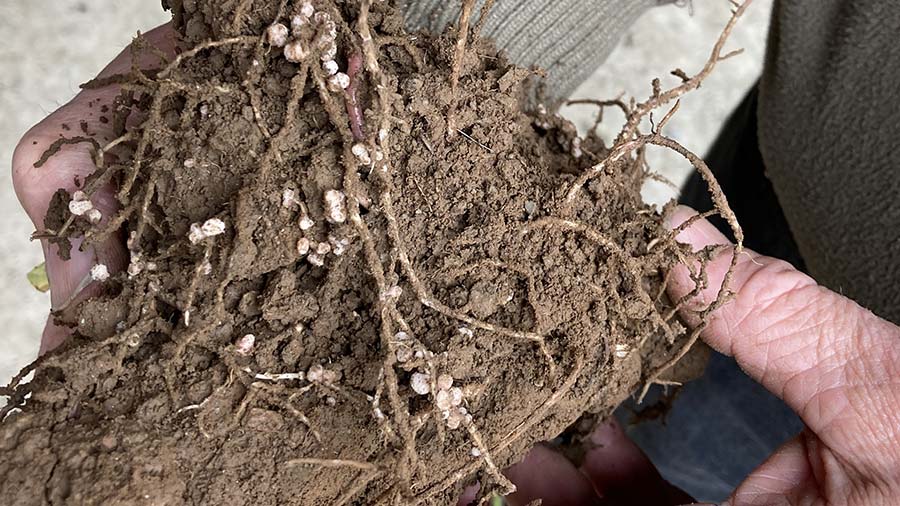Beef farmer replaces bought-in protein with home-grown pulses
 Pantyderi Farm cattle © Debbie James
Pantyderi Farm cattle © Debbie James A Pembrokeshire beef farm has reduced its winter feed costs by £33/t by replacing a bought-in protein blend with home-grown beans and peas.
The Jones family grew 8ha of the crop at Pantyderi Farm, Boncath, as part of their project work as Farming Connect demonstration farmers.
The pulses replaced a 36% protein concentrate blend.
This had been fed at a rate of 1-1.5kg a head a day, with grass silage and home-grown, urea-treated crimped barley in the growing and finishing rations of 400 head of cattle.
See also: How to become 100% protein efficient by establishing multi-species leys
Eurig Jones, who farms with his father, Wyn, says it is an important step towards a goal of self-sufficiency in protein in the beef enterprise.
Farm facts
- 445ha (1,100 acres) farmed across two units and offlying land
- 80 spring-calving Hereford-cross suckler cows sired to a Limousin bull
- Store cattle purchased for fattening – about 200 finished annually
- 1,500 Texel-cross ewes
Feed value
The crop, which he harvested on 3 September, analysed at 16.4% protein as fed, 13.6 metabolisable energy (ME) and 61.7% dry matter (DM) and achieved a protein yield as fed of 860kg/ha as a crimped feed.
Costings calculated by the project’s nutritionist Hefin Richards priced the feed at £242/t DM.
This was £33/t less than the concentrate blend – a feed based on rapeseed meal and maize distillers’ grains, which cost £275/t.
Not only is the mix cheaper, but Mr Richards points out that the cost is consistent year on year and is not dependent on the volatile protein market.
In January 2021, for example, soya prices peaked at £480/t and were still at £472/t in early March 2022.
“The more feed a farm can produce itself, the less exposed it is to that volatility, and that resilience is repeated year after year,’’ says Mr Richards, of nutrition consultancy Rumenation.
“We are also now in a place where the environmental considerations for growing feed are equal to the economic ones.”
The Jones family considered growing single crops of beans or lupins, but thought yields could be improved significantly by bicropping beans and peas and crimping them.
This allowed for storage in an outside clamp, with the feed processed at harvest and ready for feeding out in the winter.
Crop husbandry
The crop favours free-draining soil and responds well to plentiful moisture, which made it a good match for the conditions at Pantyderi.
The pH of the soil in the trial field tested at 5.8. Lime was applied at a variable rate of 937kg/ha (379kg/acre) to raise the pH closer to 6.5 – the ideal for beans and peas.
Farmyard manure was applied at 25t/ha (9t/acre), and there was no requirement for nitrogen inputs.

Farmers Wyn and Eurig Jones, Delana Davies of Farming Connect, nutritionist Hefin Richards, and Ben Burgess of Agrii © Debbie James
The growth habits of beans and peas are very complementary. The beans provide a strong scaffold, which helps keep the peas standing later in the season.
The two crops also benefit from the same agronomy approach, says Farming Connect technical officer Delana Davies, who managed the trial.
Forage quality
Beef producers are advised to improve forage quality as a starting point for increasing feed protein sources.
At Pantyderi, by cutting grass silage earlier from reseeded leys containing clover, the past two years’ harvests have analysed at 16.4% crude protein compared with 10.5% previously.
Beef farms tend to make more mature silage, favouring bulk over quality, but when silage analyses at 11-12% protein, other protein sources are needed to raise the level in the ration.
“There needs to be a greater focus on cutting silage younger and cutting from younger leys to get better-quality and higher-protein yields,” Hefin Richards suggests.
“Growing silage with 16.4% protein has had a big impact on how much protein is needed to balance the ration at Pantyderi.”
“Double cropping tends to synchronise any varietal differences with regard to time to maturity, and the peas fill the air gaps between the larger particle size of the beans in the clamp,” Dr Davies explains.
The seed was planted in two passes on 22 April. The beans were sown first at a rate of 308kg/ha (113kg/acre) and a depth of 60mm followed by the peas at 225kg/ha (91kg/acre) and at a depth of 30mm.
These seed rates were calculated using an app available through the Processors and Growers Research Organisation.
A fungicide was applied twice to tackle chocolate spot.
Mr Jones harvested the crop with his own combine, fitted with a side knife. “The side knife is a must, an essential bit of kit for the job,” he says.
Getting the timing right was a balance between having the crop dry enough to go through the combine and ensuring the moisture content was above 30% for crimping.
Yield
The crop yielded 42t from 8ha – an average of 5.25t/ha. It also produced 22 bales/ha of haulm, the fibrous part of the plants that is nutritionally superior to straw.
In systems where soya is fed, soya is cheaper, at £0.83/kg of protein, compared to £1.08/kg for peas and beans.
Ration costs
The rations formulated by Hefin Richards for growing and finishing cattle at Pantyderi show a cost benefit from including the mix of beans and peas and a marginal uplift in predicted liveweight gain.
The 2021 growing diet is costed at £1.29 a head a day compared with £1.35 a head a day in 2020. The predicted daily liveweight gain is 1.19kg a head compared with 1.15kg in 2020.
In the finishing diet, cost is reduced to £2.18 a head a day from £2.39 in 2020. The predicted daily liveweight gain is 1.44kg a head compared with 1.43kg last year.
This reflects the higher starch and energy content of the wholegrain peas and beans compared to a protein blend based on by-products.
But, with some milk and beef contracts now stipulating that soya must not be fed, Mr Richards says these figures must not be taken in isolation. Other benefits need to be factored in.
“There is a real benefit to a cereal crop that follows because soil fertility is lifted by the nitrogen-fixing characteristics of beans and peas.
“This combination crop is definitely worth consideration,” he says.

© Debbie James
Project costings incorporating contractor fees and field rental cost |
||
|
Contractor costs |
£/ha |
£/acre |
|
Rent (6 months) |
185 |
74.87 |
|
Ploughing |
63.33 |
25.63 |
|
Lime (50% of cost allocated as residual benefit to following crop) |
20 |
8.09 |
|
Spring tine x 2 |
80.80 |
32.70 |
|
Drill x 2 |
100 |
40.47 |
|
Pea seed |
90 |
36.42 |
|
Bean seed |
120 |
48.56 |
|
Roll |
18 |
7.28 |
|
Spray x 3 |
39 |
15.78 |
|
Pre-emergence herbicide (chemical cost) |
53.94 |
21.83 |
|
Fungicide x 2 (chemical cost) |
47.58 |
19.26 |
|
Combine |
100 |
40.47 |
|
TOTAL |
917.65 |
371.36 |
|
Haulm value £100/t DM |
||
|
Haulm value @32% DM |
32 |
|
|
Haulm yield t/ha (acre) |
12 |
4.86 |
|
Baling and wrapping |
125 |
50.57 |
|
Additive £2.78/bale |
61 |
24.69 |
|
Net haulm value |
198 |
80.13 |
|
Net cost peas/beans |
719.65 |
291.29 |
|
Yield t/ha (acre) |
5.25 |
2.12 |
|
Cost/t |
137.08 |
|
|
Crimping £/t |
14 |
|
|
Additive £/t |
10 |
|
|
Cost/t fresh weight |
161.08 |
|
|
Cost/t DM (62%) |
259.80 |
|
|
Cost adjusted for 10% DM losses |
285.78 |
|
|
15% moisture content as fed equivalent |
242.91 |
|
See a video of Eurig Jones combining and crimping peas and beans grown together. Video courtesy of David Lobley on YouTube.
